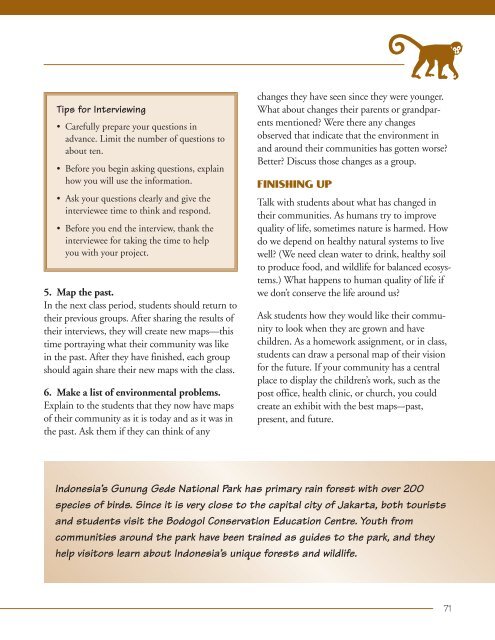EXPLORING BIODIVERSITY: A Guide for Educators Around the World
EXPLORING BIODIVERSITY: A Guide for Educators Around the World
EXPLORING BIODIVERSITY: A Guide for Educators Around the World
Create successful ePaper yourself
Turn your PDF publications into a flip-book with our unique Google optimized e-Paper software.
a<br />
Tips <strong>for</strong> Interviewing<br />
• Carefully prepare your questions in<br />
advance. Limit <strong>the</strong> number of questions to<br />
about ten.<br />
• Be<strong>for</strong>e you begin asking questions, explain<br />
how you will use <strong>the</strong> in<strong>for</strong>mation.<br />
• Ask your questions clearly and give <strong>the</strong><br />
interviewee time to think and respond.<br />
• Be<strong>for</strong>e you end <strong>the</strong> interview, thank <strong>the</strong><br />
interviewee <strong>for</strong> taking <strong>the</strong> time to help<br />
you with your project.<br />
5. Map <strong>the</strong> past.<br />
In <strong>the</strong> next class period, students should return to<br />
<strong>the</strong>ir previous groups. After sharing <strong>the</strong> results of<br />
<strong>the</strong>ir interviews, <strong>the</strong>y will create new maps––this<br />
time portraying what <strong>the</strong>ir community was like<br />
in <strong>the</strong> past. After <strong>the</strong>y have finished, each group<br />
should again share <strong>the</strong>ir new maps with <strong>the</strong> class.<br />
6. Make a list of environmental problems.<br />
Explain to <strong>the</strong> students that <strong>the</strong>y now have maps<br />
of <strong>the</strong>ir community as it is today and as it was in<br />
<strong>the</strong> past. Ask <strong>the</strong>m if <strong>the</strong>y can think of any<br />
changes <strong>the</strong>y have seen since <strong>the</strong>y were younger.<br />
What about changes <strong>the</strong>ir parents or grandparents<br />
mentioned? Were <strong>the</strong>re any changes<br />
observed that indicate that <strong>the</strong> environment in<br />
and around <strong>the</strong>ir communities has gotten worse?<br />
Better? Discuss those changes as a group.<br />
FINISHING UP<br />
Talk with students about what has changed in<br />
<strong>the</strong>ir communities. As humans try to improve<br />
quality of life, sometimes nature is harmed. How<br />
do we depend on healthy natural systems to live<br />
well? (We need clean water to drink, healthy soil<br />
to produce food, and wildlife <strong>for</strong> balanced ecosystems.)<br />
What happens to human quality of life if<br />
we don’t conserve <strong>the</strong> life around us?<br />
Ask students how <strong>the</strong>y would like <strong>the</strong>ir community<br />
to look when <strong>the</strong>y are grown and have<br />
children. As a homework assignment, or in class,<br />
students can draw a personal map of <strong>the</strong>ir vision<br />
<strong>for</strong> <strong>the</strong> future. If your community has a central<br />
place to display <strong>the</strong> children’s work, such as <strong>the</strong><br />
post office, health clinic, or church, you could<br />
create an exhibit with <strong>the</strong> best maps–-past,<br />
present, and future.<br />
Indonesia’s Gunung Gede National Park has primary rain <strong>for</strong>est with over 200<br />
species of birds. Since it is very close to <strong>the</strong> capital city of Jakarta, both tourists<br />
and students visit <strong>the</strong> Bodogol Conservation Education Centre. Youth from<br />
communities around <strong>the</strong> park have been trained as guides to <strong>the</strong> park, and <strong>the</strong>y<br />
help visitors learn about Indonesia’s unique <strong>for</strong>ests and wildlife.<br />
71

















